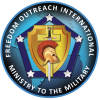
 Home
About Us
Our Pastors
Media
Blog
Moving To Guam
Ministry Partners & Resources
Contact Us
Home
About Us
Our Pastors
Media
Blog
Moving To Guam
Ministry Partners & Resources
Contact Us

It all started with an unhappy housewife� in post WWII Europe, the American military prepared for the long occupation of the continent by building small American style cities on US Bases. For the first time in US
Military history soldiers sent overseas for their assignments were allowed to take their families with them. Attempts were made to make these bases small enclaves of American culture to feel like �back home USA� for the warrior and
his family. Schools, stores, recreation areas and even chapels were set up to make things easier for the three and four year tours of duty they were expected to endure.
At first all went well. Neither the soldier or family expected things to be just like home and the contrast to the alternative of having to stay in the USA while soldiers spent months and years away on a
distant battlefield was a welcome difference. One of the items of early discontent, however, were the chapels provided for the soldier and his family. A key liberty for the American is the right to worship in the manner in which
they choose. Chapels, in those days, gave soldiers three broad choices; Catholic, Jewish, or Protestant-the later choice was overwhelmingly dominated by �High-Church� pastors and controlled by a �General Protestant� order of
service. While some were satisfied with this offering, most were not used to the limitations of these formal surroundings as their only opportunity to worship God. Soldiers, often encouraged by the unhappiness reflected in the
faces of their families, sought something more. Soldiers began securing the permission of their commanders to hold services in the chapel during the week or on Sunday evening. These services were led by the soldiers themselves in a
manner more closely aligned to their own denominational style and tradition.
The initial offering was the �Pentecostal fellowship� and scores of these groups sprang up on US installations across Europe and Asia. As these groups became aware of each other they started the practice of
gathering on American holidays for fellowship, worship and mutual encouragement. By 1959 the informal leadership of these groups became increasingly aware of a glaring weakness in their organizational structure; no
process was in place to oversee leadership succession. A thriving group often was devastated when their leadership rotated because no system was in place to ensure leaders were trained and appointed in a timely manner. An informal
council was held and leaders were asked to petition their denominational headquarters to send a missionary to aid in this process. Initially, no denomination officially responded to those requests. In January 1961, Don
Amison, one of the early fellowship leaders, curtailed his army career and traveled over at his own expense to help organize the work in Europe. From these simple efforts of connecting for fellowship the ministry to the military
was born. Soon a regular schedule of retreats, training events and local ministry centers was added to the structure of independent Pentecostal fellowships. Today, ministry centers operate in the Far East, Europe, and the
USA.